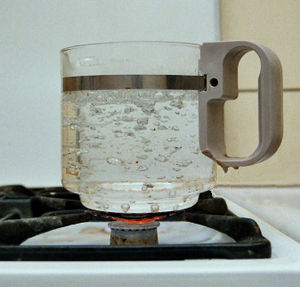Boiling point: Difference between revisions
J.williams (talk | contribs) m (1 revision imported) |
energy>Luisa No edit summary |
||
| Line 1: | Line 1: | ||
[[Category:Done | [[Category:Done 2021-01-31]] | ||
[[Category:Translated to Spanish]] | |||
[[es:Punto de ebullición]] | |||
[[File:boilingwata.jpg|300px|thumb|Figure 1. Water has a boiling point of 100<sup>o</sup>C at sea level pressure conditions.<Ref>Wikimedia Commons [Online], Available: http://upload.wikimedia.org/wikipedia/commons/1/18/Kochendes_wasser02.jpg</ref>]] | [[File:boilingwata.jpg|300px|thumb|Figure 1. Water has a boiling point of 100<sup>o</sup>C at sea level pressure conditions.<Ref>Wikimedia Commons [Online], Available: http://upload.wikimedia.org/wikipedia/commons/1/18/Kochendes_wasser02.jpg</ref>]] | ||
<onlyinclude>'''Boiling point''' is the [[temperature]] that a [[liquid]] will [[phase change|change phase]] into a [[gas]]. Boiling occurs when the [[ | <onlyinclude>'''Boiling point''' is the [[temperature]] that a [[liquid]] will [[phase change|change phase]] into a [[gas]]. Boiling occurs when the [[vapour pressure]] of a liquid is equal to the atmospheric [[pressure]] of the gas outside of it.</onlyinclude> Because of this, as the outside pressure changes so does the boiling point of the liquid. Therefore there is a set pressure known as a [[standard atmosphere]] (atm) which determines what is called the ''normal boiling point'' of a liquid. For example, [[water]]'s normal boiling point is [[celsius|100<sup>o</sup>C]], which occurs when the atmospheric pressure is exactly 1 atm. If the atmospheric pressure is less than 1 atm, the boiling point of the liquid will decrease, as is the case at higher altitudes on Earth. And if the atmospheric pressure is greater than 1 atm, such as in a pressure cooker, the boiling point will begin to increase drastically.<ref name=chem>Purdue Chemistry, ''Boiling'' [Online], Available: https://www.chem.purdue.edu/gchelp/liquids/boil.html</ref> | ||
If a liquid is undergoing a phase change, its temperature will not increase until it is done.<ref name=hyp>Hyperphysics, ''Boiling point'' [Online], Available; http://hyperphysics.phy-astr.gsu.edu/hbase/kinetic/vappre.html#c4</ref> This is known as [[latent heat]], and is common among all phase changes. | If a liquid is undergoing a phase change, its temperature will not increase until it is done.<ref name=hyp>Hyperphysics, ''Boiling point'' [Online], Available; http://hyperphysics.phy-astr.gsu.edu/hbase/kinetic/vappre.html#c4</ref> This is known as [[latent heat]], and is common among all phase changes. | ||
Another factor that determines the boiling point is [[molecule|molecular bonds, structure and composition]]. If the intermolecular forces in a liquid are relatively strong, the boiling point will be relatively high, and if the forces are relatively weak the boiling point will be relatively low.<ref name=chem/> For example, Ammonia has a very low boiling point, at -35.5<sup>o</sup>C, while [[mercury]] has a boiling point of 356.9<sup>o</sup>C.<ref>Engineering toolbox, ''Boiling Points of some common Fluids and Gases'' [Online], Available: http://www.engineeringtoolbox.com/boiling-points-fluids-gases-d_155.html</ref> | Another factor that determines the boiling point is [[molecule|molecular bonds, structure and composition]]. If the intermolecular forces in a liquid are relatively strong, the boiling point will be relatively high, and if the forces are relatively weak the boiling point will be relatively low.<ref name=chem/> For example, Ammonia has a very low boiling point, at -35.5<sup>o</sup>C, while [[mercury]] has a boiling point of 356.9<sup>o</sup>C.<ref>Engineering toolbox, ''Boiling Points of some common Fluids and Gases'' [Online], Available: http://www.engineeringtoolbox.com/boiling-points-fluids-gases-d_155.html</ref> | ||
==For Further Reading== | |||
*[[Chemical bond]] | |||
*[[Latent heat]] | |||
*[[Melting point]] | |||
*[[Temperature]] | |||
*Or explore a [[Special:Random|random page]] | |||
==References== | ==References== | ||
{{reflist}} | {{reflist}} | ||
[[Category:Uploaded]] | [[Category:Uploaded]] | ||
Revision as of 22:14, 9 September 2021

Boiling point is the temperature that a liquid will change phase into a gas. Boiling occurs when the vapour pressure of a liquid is equal to the atmospheric pressure of the gas outside of it. Because of this, as the outside pressure changes so does the boiling point of the liquid. Therefore there is a set pressure known as a standard atmosphere (atm) which determines what is called the normal boiling point of a liquid. For example, water's normal boiling point is 100oC, which occurs when the atmospheric pressure is exactly 1 atm. If the atmospheric pressure is less than 1 atm, the boiling point of the liquid will decrease, as is the case at higher altitudes on Earth. And if the atmospheric pressure is greater than 1 atm, such as in a pressure cooker, the boiling point will begin to increase drastically.[2]
If a liquid is undergoing a phase change, its temperature will not increase until it is done.[3] This is known as latent heat, and is common among all phase changes.
Another factor that determines the boiling point is molecular bonds, structure and composition. If the intermolecular forces in a liquid are relatively strong, the boiling point will be relatively high, and if the forces are relatively weak the boiling point will be relatively low.[2] For example, Ammonia has a very low boiling point, at -35.5oC, while mercury has a boiling point of 356.9oC.[4]
For Further Reading
- Chemical bond
- Latent heat
- Melting point
- Temperature
- Or explore a random page
References
- ↑ Wikimedia Commons [Online], Available: http://upload.wikimedia.org/wikipedia/commons/1/18/Kochendes_wasser02.jpg
- ↑ 2.0 2.1 Purdue Chemistry, Boiling [Online], Available: https://www.chem.purdue.edu/gchelp/liquids/boil.html
- ↑ Hyperphysics, Boiling point [Online], Available; http://hyperphysics.phy-astr.gsu.edu/hbase/kinetic/vappre.html#c4
- ↑ Engineering toolbox, Boiling Points of some common Fluids and Gases [Online], Available: http://www.engineeringtoolbox.com/boiling-points-fluids-gases-d_155.html

